The Crucial BX200 (480GB & 960GB) SSD Review: Crucial's First TLC NAND SSD
by Billy Tallis on November 3, 2015 9:00 AM ESTRandom Read Performance
Our random read performance test is conducted on a full drive and tests queue depths from 1 to 32. We focus primarily on the lower queue depths that are typical of interactive use, but also look at how the performance and power scales to more intensive loads. For desktop use, searching and virus scanning are typically the biggest sources of random reads, and they can exercise some of the larger queue depths. When working on a fragmented filesystem or with lots of small files, random I/O performance (especially for low queue depths) comes into play.
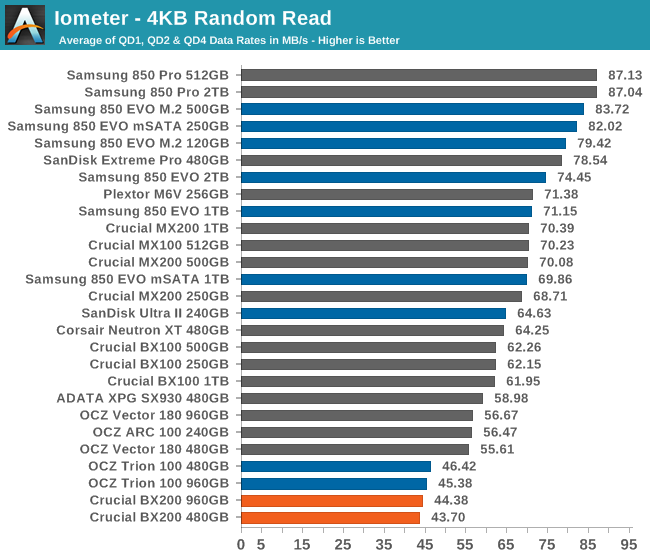
Random reads are slow, but at least the BX200 has company. This is what slow TLC flash does, but unlike many other results so far, this performance is not cause for major concern.
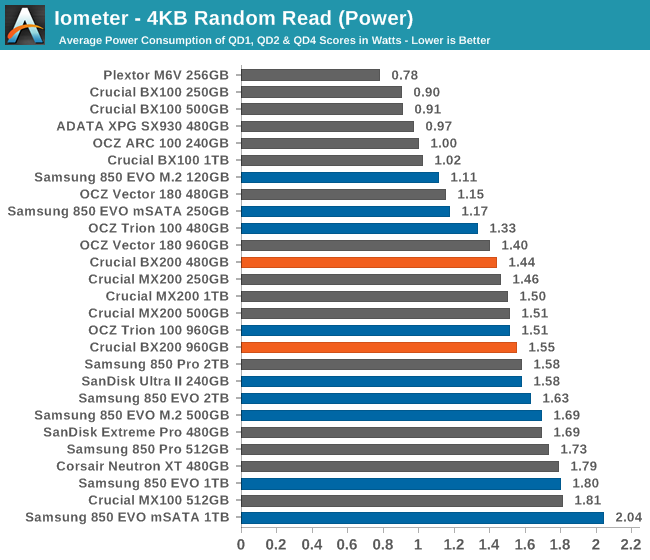
Power consumption is in the middle of the pack, so the BX200 is doing something (almost) right when handling reads.
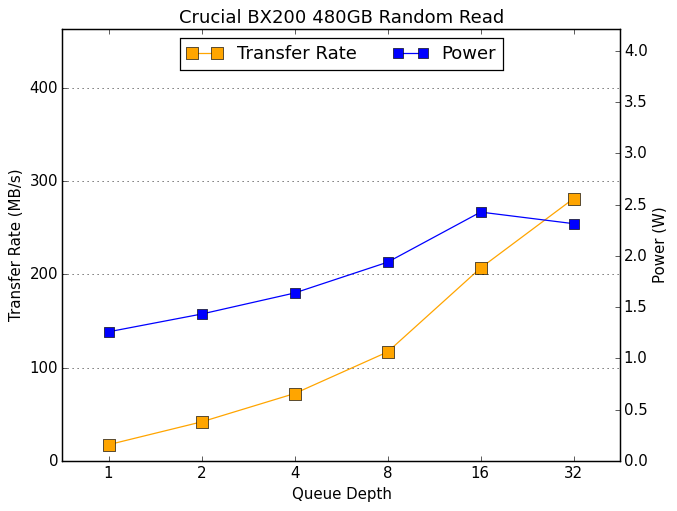 |
|||||||||
| Default | |||||||||
Performance scales smoothly as queue depth increases but it still starts low and never reaches very high.
Random Write Performance
The random write test is confined to a 16GB portion of the drive, which is otherwise empty and fresh from a secure erase. This gives the drive the chance to demonstrate much higher performance than on our performance consistency test that fills the drive. Tasks like installing software updates can modify a lot of files, but aren't hitting the entire disk. Random writes to the entire disk are usually found only in enterprise workloads such as large databases.
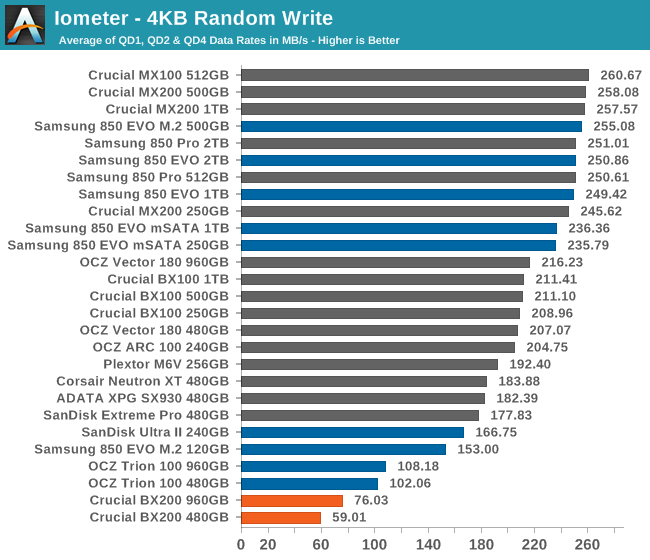
Our Iometer tests run for three minutes at each queue depth, so within 9 minutes the BX200 is clearly having trouble. The higher capacity of the the 960GB drive seems to help a lot, which suggests that the 240GB BX200's performance might be much worse than that of the 480GB.
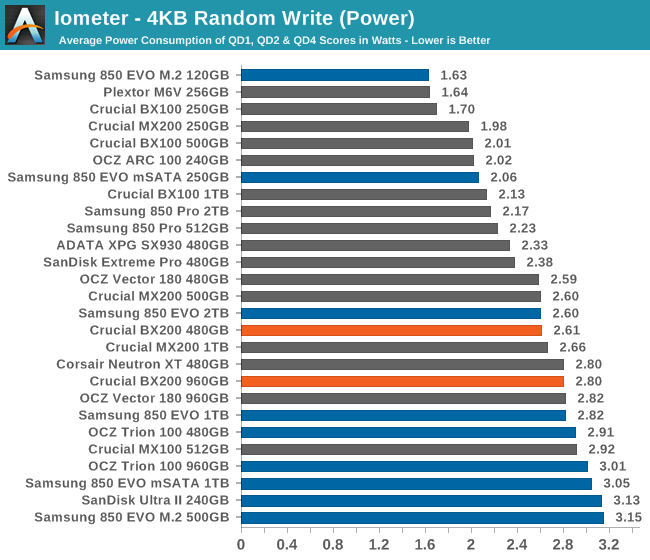
Power consumption is normal for a TLC drive, which suggests that there are a lot of background writes being done by the drive that are keeping power consumption up in spite of how little real work is getting done.
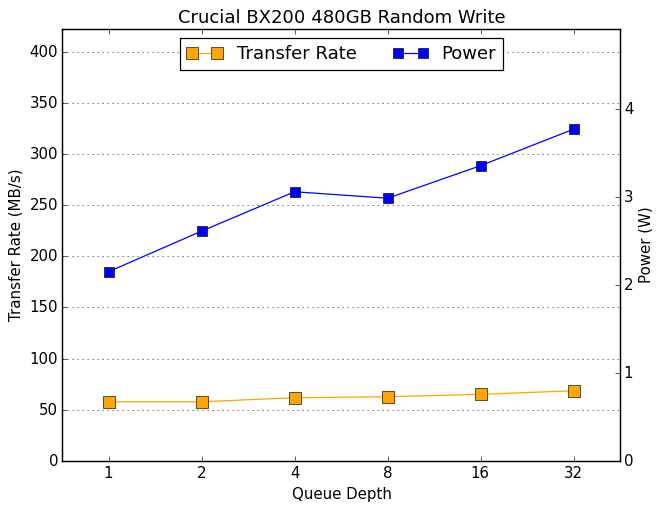 |
|||||||||
| Default | |||||||||
Random write performance hardly scales at all with increased queue depth, which is very uncommon but we have seen similar behavior from the OCZ Trion 100. Power consumption does increase dramatically, so the drive is clearly mismanaging the load of heavy writes.










85 Comments
View All Comments
zeeBomb - Sunday, November 8, 2015 - link
Less bits the better?Dahak - Tuesday, November 3, 2015 - link
So I had primarily just skimmed the article, but for a successor to the BX100 its not.I wonder if there is some firmware bug that might be causing an issue.
I have used the BX100s fine in general office settings, but i many need to pass on these and start to look for an alternative
mczak - Tuesday, November 3, 2015 - link
Honestly I think the BX200 as a cheap SSD makes sense. The problem with the BX100 was that it was "too good". There was just about no difference in performance to the MX200 (faster in some benchmarks even), there was some feature differences (for instance no AES encryption, albeit this seems to have been an artificial firmware limitation as the controller supports it) but who cares about that in client ssds. But on the downside, there was just about no price difference to the MX200 neither, some shops selling some capacities of the BX100 actually for more than the same capacities for the MX200 sometimes. So the Crucial BX100 and MX200 were really pretty much the same in nearly all aspects.But with BX200 this changes - the MX200 now clearly is the better product, but the BX200 definitely is cheaper (or at least retail prices really need to be cheaper). Albeit the benchmarks are definitely concerning - even with tlc nand it shouldn't be THAT bad, maybe indeed the firmware is to blame.
hojnikb - Tuesday, November 3, 2015 - link
Actually, TLC is pretty bad and is mostly the sole reason why this drive performs so badly. Remove the SLC cache and it would be much worse (especially on paper).mczak - Tuesday, November 3, 2015 - link
I don't quite agree. There's other tlc nand ssds in the benchmarks. Even if you exclude the 850 Evo (with its 3d nand) there's still the (toshiba tlc nand based) ocz trion 100. And this performs quite ok - sure it's not exactly leading but it doesn't trail by huge amounts in some benchmarks like the bx200 does. I'd have expected the bx200 to perform close to that rather than a league of its own as far as slow ssds go... I don't know though if that's due to differences between toshiba tlc and micron tlc or if that's due to controllers.Drumsticks - Tuesday, November 3, 2015 - link
It can't be *just* the NAND. The other TLC based drives in the charts perform much closer to "mainstream" than "absolutely terrible at everything"hojnikb - Tuesday, November 3, 2015 - link
its pretty hard to make good tlc. so yeah, tlc from micron simply sux. no other way around it.its no controllers fault, as it should perform just fine on its own, since its based off *46
DanNeely - Tuesday, November 3, 2015 - link
Assuming the street price does settle in at a reasonable discount to MSRP (and thus is cheaper than most other budget drives), these look like a reasonable option for office work. It look ~4 minutes of sustained full writes for the 480GB model to choke. Outside of photo/video editing the only time a normal user is going to hit that long of a sustained write is for OS or very large software installs. The rest of the time, most writes will be a few seconds at most before an idle period gives the drive time to catch up and flush the ram/SLC caches; meaning they should mostly sit in the (short) burst where the drives IO is similar to what much higher end drives achieve; and most longer operations will still fit in the middle plateau which is similar in performance to most budget drives on the market.beginner99 - Tuesday, November 3, 2015 - link
Too expensive or too low performance. I think everyone can afford that $20 to step up to a MX200 or similar. And this $20 is more than worth it given the extra performance. Off topic but I would also like how older SSDs fare in these benches just as a comparison. Say I have an intel G2, will I actually gain anything noticeable from moving to a new SSD?Mangosteen - Thursday, November 5, 2015 - link
Yup! You can go to anandtechs excellent bench:http://anandtech.com/bench/SSD/65
The 2013 benchmarks include a "Intel X25-M G2 160GB" (or the 80GB) which is what I'm going to assume is an Intel G2.
You can compare 1 to 1 with any SSD for example with a 250GB 850 Evo you see big gains just about everywhere, so you will definitely gain performance but will that actually be noticeable to you i have no idea because it depends on what you will use it for. For sure it won't be AS big a gap as going from a HDD to an SSD was but you may notice some small gains. It's hilarious because in the overall listing of all the ssd's there is a "Velociraptor 10,000 rpm" HDD to compare to the SSD's which is awesome. Keep in mind also that you get a new (probably better) warranty and a larger guaranteed durability.